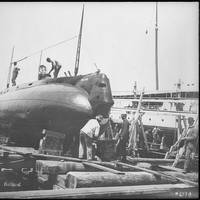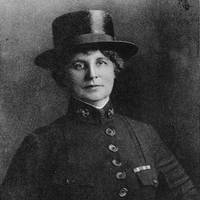Today in U.S. Naval History: April 11

Today in U.S. 1970 - Launch of Apollo 13, commanded by Capt. James A. Lovell, Jr., USN. Former naval aviator Fred W. Haise, Jr. was the Lunar Module Pilot. While 200,000 miles from Earth there was an explosion on board which forced Apollo 13 to circle the moon without landing. Mission duration was five days, 22 hours and 54 minutes. Recovery was by HS-4 helicopters from USS Iwo Jima (LPH-2). 1991 - U.N. For more information about naval history, visit the Naval History and Heritage Command website at history.navy.mil.
Today in U.S. Naval history: November 11

Today in U.S. 1870 - Navy expedition to explore the Isthmus of Tehuantepec, southern Mexico, commanded by Capt. Robert W. Shufeldt, enters the Coatzacoalcos River to begin a survey for possible interoceanic canal. Support provided by USS Kansas and USS Mayflower. 1918 - Armistice ends World War I. 1920 - Lenah S. Higbee becomes the first woman to be awarded the Navy Cross. It was awarded for her World War I service. 1921 - Washington Naval Conference begins. 1943 - Two Carrier Task Forces strike Japanese shipping at Rabaul, sinking one carrier and damaging other ships.
This Day in U.S. Naval History - April 11
1783 - Congress declares end of war with Great Britain 1900 - Navy accepted its first submarine, USS Holland 1970 - Launch of Apollo 13, commanded by CAPT James A. Lovell, Jr., USN. Former naval aviator Fred W. Haise, Jr. was the Lunar Module Pilot. While 200,000 miles from Earth there was an explosion on board which forced Apollo 13 to circle the moon without landing. Mission duration was 5 days, 22 hours, and 54 minutes. Recovery was by HS-4 helicopters from USS Iwo Jima (LPH-2). 1991 - U.N. ceasefire ends Persian Gulf War (Source: Navy News Service)
This Day in U.S. Naval History – December 21
1861 - Congress authorizes the Medal of Honor, the Nation's highest award, for Naval personnel. 1943 - USS Grayling (SS-208) sinks fourth Japanese ship since 18 December. 1951 - First helicopter landing aboard a hospital ship, USS Consolation. 1968 - Launch of Apollo 8 with Captain James A. Lovell, Jr. as Command Module Pilot. During the mission Lovell was one of the first two people to see the far side of the moon. The mission lasted 6 days and 3 hours, and included 10 moon orbits. Recovery was by HS-4 helicopters from USS Yorktown (CVS-10). (Source: Navy News Service)
This Day in U.S. Naval History – November 11
1870 - Navy expedition to explore the Isthmus of Tehuantepec, southern Mexico, commanded by CAPT Robert W. Shufeldt, enters the Coatzacoalcos River to begin a survey for possible interoceanic canal. Support provided by USS Kansas and USS Mayflower. 1918 - Armistice ends World War I. 1920 - Lenah S. Higbee becomes the first woman to be awarded the Navy Cross. It was awarded for her World War I service. 1921 - Washington Naval Conference begins. 1943 - Two Carrier Task Forces strike Japanese shipping at Rabaul, sinking one carrier and damaging other ships. Raid was first use of SB2C Curtiss Helldivers in combat. 1954 - November 11 designated as Veterans Day to honor veterans of all U.S. 1966 - Launch of Gemini 12, with CDR James A. Lovell, Jr., USN the command Pilot.
This Day in Naval History – Dec. 21
1861 - Congress authorizes the Medal of Honor, the Nation's highest award, for Naval personnel. 1943 - USS Grayling (SS-208) sinks fourth Japanese ship since 18 December. 1951 - First helicopter landing aboard a hospital ship, USS Consolation. 1968 - Launch of Apollo 8 with Captain James A. Lovell, Jr. as Command Module Pilot. During the mission Lovell was one of the first two people to see the far side of the moon. The mission lasted 6 days and 3 hours, and included 10 moon orbits. Recovery was by HS-4 helicopters from USS Yorktown (CVS-10). (Source: Navy News Service)
This Day in Naval History – Nov. 11
1870 - Navy expedition to explore the Isthmus of Tehuantepec, southern Mexico, commanded by CAPT Robert W. Shufeldt, enters the Coatzacoalcos River to begin a survey for possible interoceanic canal. Support provided by USS Kansas and USS Mayflower. 1918 - Armistice ends World War I. 1920 - Lenah S. Higbee becomes the first woman to be awarded the Navy Cross. It was awarded for her World War I service. 1921 - Washington Naval Conference begins. 1943 - Two Carrier Task Forces strike Japanese shipping at Rabaul, sinking one carrier and damaging other ships. Raid was first use of SB2C Curtiss Helldivers in combat. 1954 - November 11 designated as Veterans Day to honor veterans of all U.S. 1966 - Launch of Gemini 12, with CDR James A. Lovell, Jr., USN the command Pilot.
This Day in Naval History – Nov. 11
1870 - Navy expedition to explore the Isthmus of Tehuantepec, southern Mexico, commanded by CAPT Robert W. Shufeldt, enters the Coatzacoalcos River to begin a survey for possible interoceanic canal. Support provided by USS Kansas and USS Mayflower. 1918 - Armistice ends World War I. 1920 - Lenah S. Higbee becomes the first woman to be awarded the Navy Cross. It was awarded for her World War I service. 1921 - Washington Naval Conference begins. 1943 - Two Carrier Task Forces strike Japanese shipping at Rabaul, sinking one carrier and damaging other ships. Raid was first use of SB2C Curtiss Helldivers in combat. 1954 - November 11 designated as Veterans Day to honor veterans of all U.S. 1966 - Launch of Gemini 12, with CDR James A. Lovell, Jr., USN the command Pilot.
This Day in Naval History - April 11
From the Navy News Service 1783 - Congress declares the end of war with . 1900 - The Navy accepted its first submarine, USS Holland (SS 1). 1970 - Launch of Apollo 13, commanded by Capt. James A. Lovell Jr. Former naval aviator Fred W. Haise Jr. was the lunar module pilot. While 200,000 miles from Earth, there was an explosion on board which forced Apollo 13 to circle the moon without landing. duration was 5 days, 22 hours and 54 minutes. Recovery was by Helicopter Anti-Submarine Squadron 4 from USS Iwo Jima (LPH 2). 1991 - A U.N. ceasefire ends the Persian Gulf War.
This Day in Naval History - Dec. 21
From the Navy News Service 1861 - Congress declares Naval personnel eligible for the Medal of Honor, the Nation's highest award. 1943 - USS Grayling (SS 208) sinks its fourth Japanese ship in three days. 1951 - The first helicopter landing aboard a hospital ship takes place aboard USS Consolation (AH 15). 1968 - Apollo 8 is launched with Capt. James A. Lovell Jr. as Command Module Pilot. During the mission, Lovell becomes one of the first three people to see the far side of the moon. The mission lasted 6 days and 3 hours, including 10 moon orbits. Helicopters from USS Yorktown (CVS 10) take care of the recovery.
This Day in Naval History - April 11
From the Navy News Service 1783 - Congress declares the end of war with Great Britain. 1900 - The Navy accepted its first submarine, USS Holland (SS 1). 1970 - Launch of Apollo 13, commanded by Capt. James A. Lovell Jr. Former naval aviator Fred W. Haise Jr. was the lunar module pilot. While 200,000 miles from Earth, there was an explosion on board which forced Apollo 13 to circle the moon without landing. Mission duration was 5 days, 22 hours and 54 minutes. Recovery was by Helicopter Anti-Submarine Squadron 4 from USS Iwo Jima (LPH 2). 1991 - A U.N. ceasefire ends the Persian Gulf War.
This Day in Naval History - Dec. 21
From the Navy News Service 1861 - Congress declares Naval personnel eligible for the Medal of Honor, the Nation's highest award. 1943 - USS Grayling (SS 208) sinks its fourth Japanese ship in three days. 1951 - The first helicopter landing aboard a hospital ship takes place aboard USS Consolation (AH 15). 1968 - Apollo 8 is launched with Capt. James A. Lovell Jr. as Command Module Pilot. During the mission, Lovell becomes one of the first three people to see the far side of the moon. The mission lasted 6 days and 3 hours, including 10 moon orbits. Helicopters from USS Yorktown (CVS 10) take care of the recovery.







